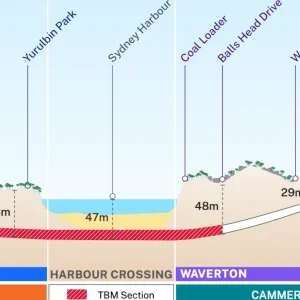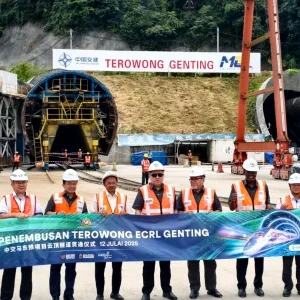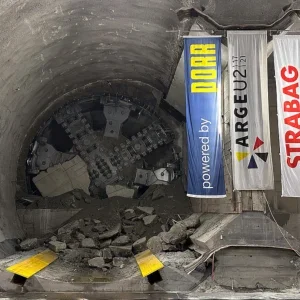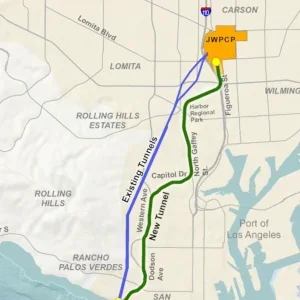Progress on the 160km long Betuweroute freight rail line in the Netherlands has stepped up a gear with breakthrough at the end of last year of the second tube of the 1.8km long Botlek tunnel, while new boring techniques on the 4.2km long Sophia twin-tube tunnel look set to increase production dramatically .
The $244M Botlek rail tunnel marks the successful completion of the country’s first tunnel to be constructed using EPB shield technology. The machine, a 9.6m diameter Herrenknecht, was driven by JV, BTC Botlek. The first tube was completed in February 2000 (News, March 2000) having averaged 10m/day from the start in March 1999.
The JV was commissioned by the Betuweroute Project Setup Team to construct the tunnel with access tunnels on either side built by cut-and-cover.
Following the success on the Botlek tunnel a spokesperson for the client told T&TI that although final research results are not yet established, it is believed that, "the EPB method can be applied with excellent effect in the soft Dutch soils, in contrast to what had been assumed recently."
Access ramps and operating facilities are currently being built as are three cross-connections between the two tunnels.
The Botlek tunnel has been designed to upgrade the existing line to twin track and alleviate a major bottleneck at the Botlek bridge over the River Oude Maas. Bored tunnelling should guarantee sufficient train capacity without impeding the busy shipping traffic on the Oude Maas during construction. The completed tunnel is scheduled to open for operation in 2002.
Meanwhile new techniques are being trialled on the $273.7M, 4.2km long twin tube Sophia tunnel, the second and longest tunnel on the Betuweroute freight line.
Contractor Tubecon 1 has completed the last test period for continual boring, claiming that it has succeeded in installing all seven elements of a full tunnel ring without interrupting the boring process. The JV has developed the technique jointly with the contract TBM manufacturer Herrenknecht especially for this job.
Boring of the first 9.8m diameter tube started in May last year (News, May 2000). The JV constructed the first 2km at a rate of 145.5m/week using traditional tunnel machine boring techniques, before starting testing the continuous method at the end of last year. The JV will now try to complete the remaining 2km of the first tube and the 4.2km of the second tube using this method and, if successful, predicts an eventual 75% increase in production.
The method rests on the concerted action of the boring machine’s 28 jacking cylinders. After boring 1.5m, a number of jacks are retracted, with the remaining cylinders taking over the pressure. This provides room for the installation of tunnel elements. In this fashion, two complete rings can be installed in the drilling head. The method requires the TBM’s hydraulic jacks and shield to be lengthened. Concrete tunnel elements are shaped to absorb the pressure of the jacks while the ring is not closed.
The test period revealed a number of teething problems. Valves in the hydraulic system had to be replaced when they did not respond quickly enough to the control systems to correct length adjustments. The original control software was also altered after it caused incorrect regulation of jacking pressure. The contractor believes these problems arose as the technique tests had only been carried out in a trial installation using 14 jacks.
Although these problems have been rectified, production is not expected to increase immediately. Workers will have to adapt to the new method and Tubecon I admits it is not fully understood how the machine would respond if several rings were installed continuously.
The complete Betuweroute line is Holland’s largest infrastructure project and the country’s first double tracked railway for freight transportation. The line will link Rotterdam with the German border as part of Europe’s high speed rail network.







